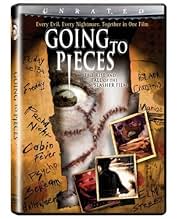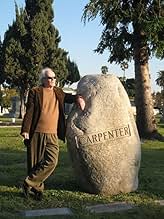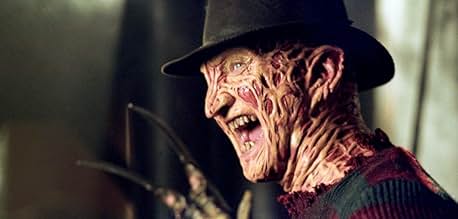IMDb RATING
7.2/10
3.7K
YOUR RATING
A documentary on the history of the slasher film.A documentary on the history of the slasher film.A documentary on the history of the slasher film.
Amy Holden Jones
- Self
- (as Amy Holden-Jones)
Anthony Timpone
- Self
- (as Tony Timpone)
Storyline
Did you know
- TriviaBased upon the novel of the same name by author Adam Rockoff
- Quotes
John Carpenter: New talents come along, old talents fade away.
- ConnectionsFeatures The War of the Worlds (1953)
Featured review
I'm a little impressed. Whether the credit belongs to director Jeff McQueen, producers Rachel Belofsky and Rudy Scalese, or the writers, this is a more meaningful, thoughtful documentary than I supposed it was going to be. I'm not saying that it's perfect, because there are embellishments here and there (music cues, title cards) that are a bit gauche, and the enthusiasm and anecdotes that some interviewees share are a bit much at times. Then again, that enthusiasm really speaks to how much fun everyone had making these movies, the passion they have for the underlying craft, and the thrill of the visceral storytelling. The feature earnestly covers a lot of ground: the violent thrillers from which slashers took influence; the art of illusion behind practical effects like blood and gore; discussion of where slashers fit into society and culture, and how they may or may not reflect that society and culture; the push to make movies that exploited every possible holiday and occasion, and every possible weapon of choice; and more. From producers and directors to effects artists and stars, we're greeted with a slew of interview subjects who offer their own perspective on the genre, with focus primarily on the golden age of the slasher from their inauguration with John Carpenter's 'Halloween' in 1978, to the early and mid 80s when slashers had more or less become the new "it" girl of horror. There is nothing in 'Going to pieces' that's a particular revelation, yet the picture gives welcome, broad perspective - or rather, retrospective - that's more sincere and ruminative than I'd have guessed before I sat to watch.
Some films get more emphasis than others, and not unreasonably; 'Halloween' began it all, 'Friday the 13th' raised the bar with crimson and viscera, and 'A nightmare on Elm Street' took things in a wild new direction. If only in passing, though, this touches upon even more flicks than I've seen, and some I'd never even heard of. Along the way, there's an early spotlight on the conventions that largely define slashers, including settings, protagonists, antagonists, murder weapons, and more - and with this in mind, one place where I think the title falters is in failing to identify how easily the genre became very formulaic, and very stale, very quickly. True, there are still many viewers who flock to slashers for the cavalcade of random violence and death, but I think there came a point where slashers became dull unless there is either some major point of brilliance to help it stand out, or some new twist on the style (e.g., 2015's 'The final girls') that really upended norms. In some measure 'The rise and fall of the slasher film' also raises reasonable questions: of what specifically defines the "slasher"; if every piece mentioned herein really is a slasher or just falls into "horror" generally, or some other subgenre; the extent to which slashers may have had influence elsewhere in horror; and ultimately how accurate the name even is, if slashers continue to be a major force in horror cinema. The documentary really does cover a lot of ground, but it could have broadened its scope even more, and despite the name it's worth observing that there's not so much a central thesis here as an overarching idea of examining the genre.
There are notions touched upon in passing that could have been explored even more deeply: the regressive, conservative values that seemingly inform killers in movies; the triumph of "the final girl" as a representation of feminism; the outdated, harmful language and ideas that "other" and demonize a subset of the population by setting up a particular type of figure as the killer (i.e., lots of ableism, homophobia, and transphobia); and so on. In fairness, to whatever extent 'Going to pieces' could have done more, maybe these were also beyond its purview, for the chief intent here was in a sort of history of the genre (as of 2006), and if imperfectly, I think it does that job very well. Whether one is a fan of slashers, or of documentaries, or just an avid cinephile at large, I think there's much to appreciate here for a lot of folks. All told it may not be something one needs to go out of their way to see, but for something light yet interesting, 'Going to pieces' is a fine movie that's well worth checking out if you have the chance.
Some films get more emphasis than others, and not unreasonably; 'Halloween' began it all, 'Friday the 13th' raised the bar with crimson and viscera, and 'A nightmare on Elm Street' took things in a wild new direction. If only in passing, though, this touches upon even more flicks than I've seen, and some I'd never even heard of. Along the way, there's an early spotlight on the conventions that largely define slashers, including settings, protagonists, antagonists, murder weapons, and more - and with this in mind, one place where I think the title falters is in failing to identify how easily the genre became very formulaic, and very stale, very quickly. True, there are still many viewers who flock to slashers for the cavalcade of random violence and death, but I think there came a point where slashers became dull unless there is either some major point of brilliance to help it stand out, or some new twist on the style (e.g., 2015's 'The final girls') that really upended norms. In some measure 'The rise and fall of the slasher film' also raises reasonable questions: of what specifically defines the "slasher"; if every piece mentioned herein really is a slasher or just falls into "horror" generally, or some other subgenre; the extent to which slashers may have had influence elsewhere in horror; and ultimately how accurate the name even is, if slashers continue to be a major force in horror cinema. The documentary really does cover a lot of ground, but it could have broadened its scope even more, and despite the name it's worth observing that there's not so much a central thesis here as an overarching idea of examining the genre.
There are notions touched upon in passing that could have been explored even more deeply: the regressive, conservative values that seemingly inform killers in movies; the triumph of "the final girl" as a representation of feminism; the outdated, harmful language and ideas that "other" and demonize a subset of the population by setting up a particular type of figure as the killer (i.e., lots of ableism, homophobia, and transphobia); and so on. In fairness, to whatever extent 'Going to pieces' could have done more, maybe these were also beyond its purview, for the chief intent here was in a sort of history of the genre (as of 2006), and if imperfectly, I think it does that job very well. Whether one is a fan of slashers, or of documentaries, or just an avid cinephile at large, I think there's much to appreciate here for a lot of folks. All told it may not be something one needs to go out of their way to see, but for something light yet interesting, 'Going to pieces' is a fine movie that's well worth checking out if you have the chance.
- I_Ailurophile
- Jan 11, 2024
- Permalink
Details
- Release date
- Country of origin
- Language
- Also known as
- Going to Pieces - el éxito y la caída del cine de destazamiento
- Filming locations
- Los Angeles, California, USA(Hollywood Forever Cemetary)
- Production companies
- See more company credits at IMDbPro
Box office
- Budget
- $600,000 (estimated)
Contribute to this page
Suggest an edit or add missing content

Top Gap
By what name was Going to Pieces: The Rise and Fall of the Slasher Film (2006) officially released in Canada in English?
Answer


































